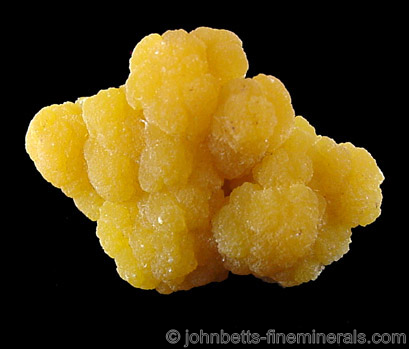The Mineral mimetite

Mimetite is a member of the Apatite group, a group of isomorphous hexagonal minerals. It is very similar in structure and appearance to Pyromorphite, and may be partially replaced by it. In fact, sometimes Mimetite and Pyromorphite are virtually indistinguishable from each other and may be wrongly labeled as the other. Mimetite is also structurally similar to Vanadinite, and may also be partially replaced by it. The intermediary member between Mimetite and Vanadinite is known as Endlichite.
Chemical Formula
Pb5(AsO4)3Cl
Color
Light yellow, lemon-yellow, dark yellow, orange, brown, reddish-brown, and yellow-green. Rarely colorless or white. May also be multicolored orange, yellow, and greenish-yellow.
Varieties
-
Wedge-shaped, orange-yellow to brown variety of Mimetite with curved faces.
Uses
Mimetite is a minor ore of lead where it occurs with more abundant lead minerals. It is also a popular mineral among collectors.
Noteworthy Localities
A classic German Mimetite locality is Johanngeorgenstadt, Saxony, Germany, where large tabular crystals had once come from. These crystals are very hard to obtain today as they are all from old collections and command very high prices. Small radiating acicular Mimetite groupings come from the Clara Mine, Oberwolfach, Baden-Württemberg, Germany. An old-time English locality is Wheal Unity, Gwennap, Cornwall, England; and the most famous Campylite occurrence in the world is the Dry Gill Mine, Caldbeck Fells, Cumbria, England.
Spiky aggregates of Mimetite crystals come from Tsumeb, Namibia; and very large whitish-yellow crystals come from Mt. Bonnie, Northern Territory, Australia.
Beautiful lustrous and gemmy crystals come from the Pingtouling Mine, Liannan Co, Guangdong Province, China; and from the Guatomo Mine ("Hat Yai"), near Tham Thalu, Yala Province, Thailand.
Mexico has several outstanding locations for this mineral. Many Mexican occurrences have Mimetite in the form of mammilary or botryoidal groupings, expecially San Pedro Corralitos, Chihuahua; and Santa Eulalia, Chihuahua. Spiky crystals and green botryoidal masses come from a new find in the famous Mapimi Mine in Durango, Mexico. Deep orange radial encrustions occur in Cerro Prieta, Sonora, also associated with Wulfenite.
In the U.S., the good locations are all but limited to several Arizona mines, specifically the the Rowley Mine, near Theba, Maricopa Co.; the Mammoth-Saint Anthony Mine, Tiger, Pinal Co.; the No. 79 Mine, near Hayden, Gila Co.; and the Sammy Dog Mine, Silver Bell District, Pima Co.
Distingushing Similar Minerals
Pyromorphite - Usually greener in color. Otherwise cannot be distinguished with practical methods.
Vanadinite - Usually redder in color, has a slightly yellow streak, and is slightly softer. Otherwise cannot be distinguished with practical methods.
Apatite - Harder (5).